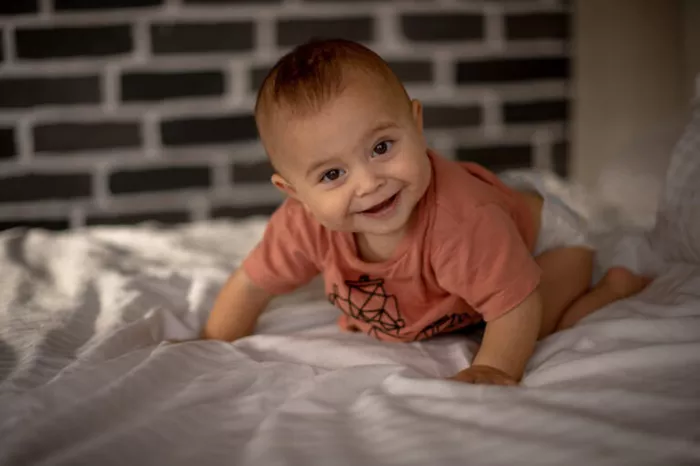Understanding the visual capabilities of newborns is essential for their early development and interaction. This article explores in detail what range a newborn can see clearly, providing insights into their visual milestones and how caregivers can support healthy vision.
Visual Acuity at Birth
Limited Focus Range
At birth, newborns have limited visual acuity. They can see objects clearly only within a range of approximately 8 to 12 inches from their face. This distance coincides with the typical distance between a baby and their caregiver during feeding and bonding moments.
Preference for High Contrast
Newborns are naturally drawn to high contrast patterns, such as black and white images or sharply contrasting colors. These patterns are easier for them to perceive and attract their attention during the early weeks of life.
Blurry Vision
Their vision at birth is quite blurry as their visual system is still developing. They may not be able to focus on distant objects or see fine details clearly.
Development of Visual Abilities in the First Month
Improving Focus
By the end of the first month, newborns start to improve their ability to focus. They may begin to track objects with their eyes within a closer range and show more interest in their surroundings.
Recognizing Faces
Newborns can recognize faces, particularly those of their caregivers, from a close distance. They respond to facial expressions and may show preference for familiar faces early on.
Introduction of Colors
While newborns initially see the world in shades of gray, they begin to perceive colors gradually. Reds and yellows are often the first colors they can distinguish, followed by greens and blues as their color vision matures.
SEE ALSO: When Can Newborns Focus Their Eyes?
Visual Development in the First Three Months
Expanding Visual Field
Around two to three months of age, babies’ vision expands beyond the immediate proximity of their face. They can start to see objects and people across the room, although their focus remains sharper at closer distances.
Enhanced Eye Coordination
Eye coordination improves as newborns learn to use both eyes together to track moving objects. This skill lays the foundation for depth perception and spatial awareness.
Interest in Visual Stimulation
Babies become more interested in visual stimulation, such as mobiles and brightly colored toys placed within their visual range. These stimuli encourage visual exploration and help in developing their visual acuity.
Visual Clarity from Three to Six Months
Clearer Focus
By three to six months, babies’ vision becomes much clearer. They can see objects and faces across a room with more precision. This clarity supports their ability to recognize familiar people and interact visually with their environment.
Color Discrimination
Color discrimination improves further, allowing babies to distinguish between a wider range of colors. They develop preferences for certain colors and may show excitement or interest in brightly colored objects.
Depth Perception
Depth perception, the ability to judge distances between objects, continues to develop during this period. Babies become more adept at reaching for and grasping objects based on visual cues.
Visual Acuity by Six Months and Beyond
Adult-Like Vision
By around six months, many babies have reached a visual acuity similar to that of adults. They have well-developed depth perception, color vision, and the ability to focus on objects both near and far.
Refining Visual Skills
Throughout the first year, babies refine their visual skills through exploration and interaction. They become more skilled at tracking moving objects, identifying familiar faces from a distance, and responding to visual cues in their environment.
Supporting Healthy Vision Development
Caregivers can support healthy vision development in newborns and infants by:
Providing visual stimulation with age-appropriate toys and books.
Ensuring adequate lighting in the baby’s environment.
Encouraging tummy time and supervised exploration to enhance visual and motor skills.
Scheduling regular pediatric check-ups to monitor visual development and address any concerns promptly.
Conclusion
Understanding what range a newborn can see clearly is crucial for parents and caregivers in promoting healthy visual development. From limited focus at birth to achieving adult-like vision by around six months, newborns undergo significant visual milestones. By providing appropriate stimulation and monitoring their progress, caregivers can support their baby’s journey towards developing strong and healthy eyesight.
FAQs
When Can a Newborn See Clearly?
Newborns do not see clearly at birth. Their vision is quite blurry initially, and they can only focus on objects that are within 8 to 10 inches from their face. However, their vision improves gradually over the first few months as their visual system matures. By around 3 months of age, many babies start to see more clearly. They can distinguish finer details, track moving objects, and recognize familiar faces from a short distance.
What Can a 2-Week-Old Baby See?
At two weeks old, a baby’s vision is still developing. They can see light, shapes, and movement, but their vision is not yet fully matured. Babies at this age are particularly attracted to high-contrast patterns such as black and white images. They can also focus on objects and faces that are close to them, within a distance of about 8 to 12 inches. While their color vision is limited initially, they begin to perceive colors gradually over the first few months.
When Do Babies Have 100% Vision?
Babies do not achieve adult-like vision of 20/20 until several years after birth. However, their visual acuity improves significantly during the first year of life. By around 6 to 12 months, many babies have developed close to adult-like vision. They can see clearly across a room, distinguish between different colors, and have good depth perception. It’s important to note that visual development can vary from baby to baby, and some may reach these milestones earlier or later than others.


